XFX’s Radeon HD 5770, A Look At The 5770 Revision 2 Cooler
by Ryan Smith on January 5, 2010 12:00 AM EST- Posted in
- Ryan's Ramblings
From our Radeon HD 5770 Review:
Interestingly enough, we’ve been told that the Phoenix shroud isn’t going to be sticking around for long. The first wave of cards launching today and for the near future will be using the shroud, but once AMD’s vendors begin using their own designs, AMD doesn’t expect most of the vendors to stick with the shroud. XFX has specifically been named as a party that will keep using the shroud on products, but anyone else is subject to change. With a TDP of only 108W, the Phoenix shroud is probably overbuilt and certainly more expensive than vendors would like, where mainstream products come with thinner margins. We would expect the vendors that do switch to move to more traditional dual-slot coolers, likely ones that aren’t shrouded at all and would not blow hot air outside of the case.
What AMD explained to us quickly came to pass, and once the first wave of 5770s sold out, the replacement waves started coming with coolers besides the Phoenix shroud. Since then we’ve had a number of people ask us how the later coolers compare to the Phoenix, and this is something that we can finally answer today.
XFX's 5770 Rev 2
XFX – who AMD named as one of the companies who would be selling the Phoenix along with other cooler designs – was kind enough to send over one of their alternative 5770 models for this cooler evaluation. Our particular interest in this card is that it uses the same egg-shrouded cooler that is appearing on the majority of 5770s seen in retail, making it the de-facto standard 5770 cooler. For the sake of simplicity, we are calling this the 5770 Revision 2 cooler. In XFX’s case, this is sold alongside cards using the Phoenix and another card using an open cooler similar to the Rev 2.
When first looking at the Rev 2, looks can be deceiving. While it does use an egg-shaped shroud very similar to that found on the 5750, the actual HSF unit is entirely different, making the similarities merely superficial. Ultimately the 5750’s HSF was a simple aluminum heatsink sitting on top of the GPU, with a fan sitting on top of the heatsink. For the 5770, a much more elaborate HSF is used, consisting of a copper block with a pair of heatpipes embedded. These heatpipes then run the entire circumference of a circular aluminum heatsink that sits on top of the copper block. Finally, sitting in the middle of the heatsink (and not above it) is the fan.

A side view of the Rev 2 cooler
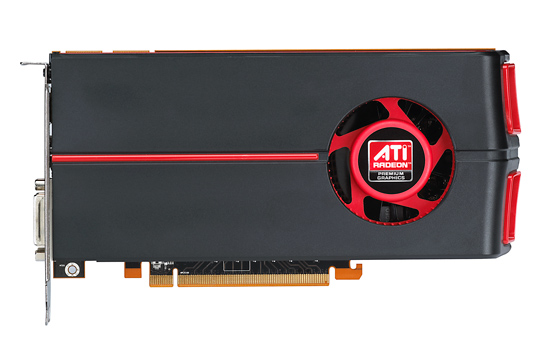
The original Phoenix cooler
In short, in spite of the visual similarities to the 5750’s cooler, the Rev 2 cooler entails a much larger heatsink using heatpipes and better fan placement. If you’ve ever seen Zalman’s VF900 GPU cooler, then the design is very similar to that.

Overall the Rev 2 is very similar to the Zalman VF900 (image courtesy Zalman)
With the change in coolers comes some space savings for the card. As the Phoenix shroud added another half-inch to the total length of the 5770, it pushed an 8.25” design out to 8.75”. With the Rev 2 cooler there is no overhang, bringing the card in at just the PCB length of 8.25”. This also means that the 6-pin PCIe power plug is no longer partially hidden by the shroud, making it easily accessible on the Rev 2.
We should note that while the cooler has changed, the PCB has not. The PCB on this card is exactly identical to the PCB on our 5770 reference card. In fact the only difference besides the cooler is the use of Samsung GDDR5 rather than Hynix GDDR5. In benchmarks there is absolutely no difference in performance between our Rev 2 card and our original reference card. So the only practical difference is the cooler.
That brings us to what kind of difference the change in coolers brings. When we first discussed the 5770, we noted that the Phoenix was probably overbuilt for the relatively low 108W TDP of a 5770. Indeed that appears to be the case, as you can see with the results of our Rev 2 cooler.
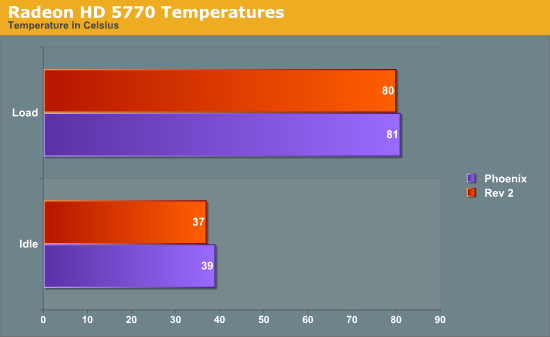
We’ll start with a look at temperatures. Our expectations for the Rev 2 cooler were for higher overall temperatures since its design means that it has to recycle some hot air rather than blowing it entirely out of computer like the Phoenix cooler does, and it’s here where we found our first surprise. Rather than being warmer than the Phoenix, the Rev 2 is cooler (if ever so slightly) in both idle and load situations. At a 2C and 1C different at idle and load respectively it’s not a huge difference, but it’s an extremely notable difference since the otherwise simpler Rev 2 cooler is clearly keeping up with and otherwise outperforming the Phoenix.
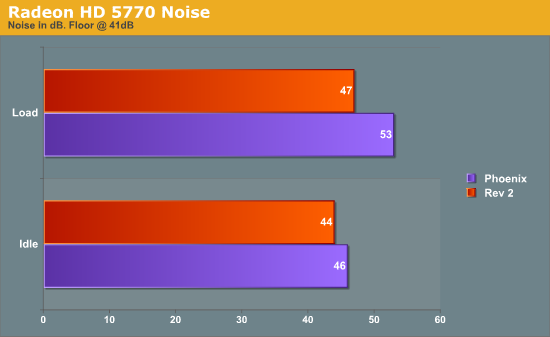
Our other surprise came in our noise tests .Surely the Phoenix would be quieter thanks to its shrouding, right? Wrong we were once again. In fact the difference is even more pronounced than the temperature differences. The Rev 2 cooler not only manages to stay quieter than the rest of the computer (something the Phoenix can’t claim) but at load the difference becomes 6dB. While the Phoenix cooler is by no means a loud cooler, the Rev 2 in comparison is whisper-silent. Even compared to itself, the Rev 2 is only 3dB louder under load than it is while idling.
Final Thoughts
Frankly, based on this data we have a hard time justifying the Phoenix over the Rev 2 cooler. The Rev 2 makes for a smaller board, a slightly cooler GPU, and a significantly quieter video card. Thusly the only advantage the Phoenix cooler has is that it completely exhausts all hot air, which in the case of our well ventilated Thermaltake case isn’t doing it any favors. Unless this card is placed in a case with extremely poor airflow, we can’t think of a situation where the Phoenix cooler is superior (and in which case, we’re left wondering whether there would be enough fresh air to satisfy the Phoenix regardless).
The Phoenix cooler may be the better looking (and 5800-series matching) cooler, but ultimately it’s not the best cooler. AMD and their partners were wise to ditch the Phoenix for the Rev 2 in most of their design, as it offers better thermal and acoustic performance, not to mention a lower resulting price (we’d peg the difference at about $10 retail). In fact at this point we’re left wondering why they launched the Phoenix at all –ultimately it would have been all the more impressive for the 5770 and cheaper for consumers if they had just launched with the Rev 2 cooler in the first place.


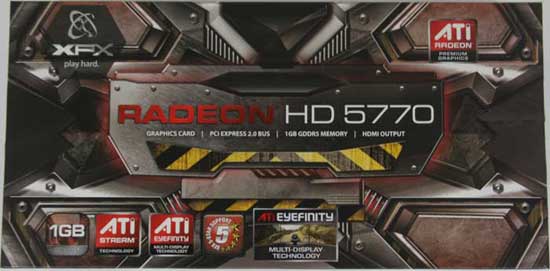
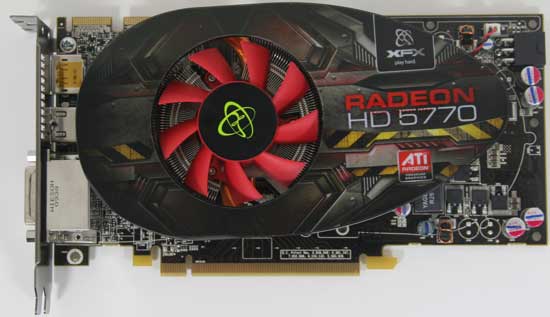








34 Comments
View All Comments
irev210 - Tuesday, January 5, 2010 - link
I had both and I thought the rev1 had an overall quieter noise profile.The rev2 had an annoying high-pitch hum compared to the rev1.
Also, you should consider that over time, the rev2 will get clogged with dust much easier due to the closer spaced fins on the heatsink, thus making the fan work harder, and louder.
PWM controlled fan on the V1 is also preferred.
marc1000 - Tuesday, January 5, 2010 - link
both fans are PWM controled, the circuit that controls the fan are on the board, so there is no need for 4 wires.about the dust, I believe that it will be a similar problem to both coolers, but on Phoenix we will not see it, and on Rev2 we will clearly see the dust.
MadMan007 - Tuesday, January 5, 2010 - link
Thanks for the quickie test. But did you measure case temps at all, or maybe see if there was any effect on mobo or CPU temps? Adding that information would make the comparison even more complete.marc1000 - Tuesday, January 5, 2010 - link
I bought one 5770 with the Phoenix as soon as I saw the rumors of this new cooler for 2 reasons: I was affraid that it could be worse-performing, and the Phoenix is really beautiful =D . It turns out that my fear was wrong, and the new cooler is actually better and more silent than the Phoenix. I almost regreted my decision, but it looks so cool that I'm fine with it! My case fans are louder than the Phoenix tough... My only concern is that it will be VERY hard to eventually remove the card from my mobo, because the security latch of the pci-e slot on my system is now hidden behind the cooler shroud.AznBoi36 - Tuesday, January 5, 2010 - link
These have been around for a while now. A friend of mine bought a Sapphire 5770 in mid December with one of these coolers. I'm glad to know that they cool better than the Phoenix. Also I'm not too surprised at both the noise levels and cooling. After all, the fan on the Rev2 is much bigger than the one on the Phoenix, along with copper heatpipes.But honestly, I loved the look of the Phoenix shroud. Having 2 in CrossFireX looks so damn sexy.
rritklin - Tuesday, January 12, 2010 - link
The new year approaching, click in. Let's facelift bar!====== h t t p : / / 0 8 4 5 . c o m / J J m =====
fr ee sh i pp ing
(jordan shoes) $32
(air max) $34
++++h t t p : / / 0 8 4 5 . c o m /J J m++++++++++
+++
wow
BelardA - Tuesday, January 5, 2010 - link
A bigger fan at slower RPMs is always quieter.I want to see the ATI 5700~5800s using improved coolers, like the ones used by some HIS cards (4670) which has a large fan and large heat-sink. These cards are very quiet.
The coolers are made by Arctic Cooling and sold as add-ons for various cards.
Having a video card that exhausts ALL heat out of the case makes for a cooler running computer, rather than blowing that HOT air onto the RAM, CPU and whatever else.
The Phoenix looks NICE, but its designed with small fan & air-intakes. Removing the 3rd (on some cards) video port will open up the exhaust port for better air flow and noise.
mindless1 - Monday, January 11, 2010 - link
Having a video card that exahausts all heat out is worse, you're just moving the problem.In order for an equivalent heatsink to move enough air out that tiny rear exhaust port on the 'sink, it has to spin faster and make more noise than a different heatsink and fan design would to keep the card at the same temperature.
Since you are sacrificing this noise level for your ideal of removing case heat, you would have had a more efficient result with slightly increased case fan size or RPM and today's quality case fans are less likely to fail than those on a video card.
Further, the entirely enclosed rear-exhausting heatsinks tend to not only clog with dust as fast or faster, they are significantly more laborious to clean dust out of with their typical shroud screws behind the metal portion facing the card - so the entire heatsink has to be lifted off the GPU for most thorough cleaning which is a bit insane if you stop and think about it.
Some will just think "oh but my case is filtered". Good idea! However, someone picking filtered cases is most often already trading higher noise for same airflow, or reducing airflow so for them apparently the noise vs temperature factor isn't a primary concern.
ULtimately we need not be concerned about open heatsinks on video cards. Any other parts in a computer that are significant producers of heat merely need to have their own design capable of adequate cooling. Most often that just means if you have a northbridge pretty far south and/or hot southbridge, it needs to have a decent sized heatsink on it.
No worries about CPU since you can pick the right cooler, hard drives up front have cool intake air flowing over them, and misc other cards seldom need much cooling.
Finally, higher ambient temperatures in a case aren't necessarily to be avoided, it only needs to last in excess of the viable lifespan of the system and remain stable doing so. Despite the capacitor plague of a few years ago, plenty of OEM systems demonstrate this running at quite a bit higher internal temps than the typical enthusiast gamer system with several 92-120mm fans in it, if not even larger ones.
If you're overclocking that changes things a bit, but still I often see people going overboard, as if 45C is a high component temperature they need to "fix" somehow and yet they accept when their GPU exceeds 60C regularly during gaming only because they don't know how or don't want to do anything about it but in the back of their mind they know 60C is not too hot for most parts in a computer.
Jedi2155 - Wednesday, January 6, 2010 - link
I purchased a Sapphire Vapor-X 5870 myself after fearing the vacuum cleaner sound of a normal 5870 and I found the card running extremely quiet and cool even on high load. Well worth the extra $20-30 for a Vapor-X model.AznBoi36 - Wednesday, January 6, 2010 - link
"Having a video card that exhausts ALL heat out of the case makes for a cooler running computer, rather than blowing that HOT air onto the RAM, CPU and whatever else."True. This is why I also prefer the Phoenix shroud. The Rev2 works great on the 5770, since that isn't a very "hot" card to begin with, but then again it's not a high-end part. Temperatures are on the low side compared to what we're used to seeing (85+ C).